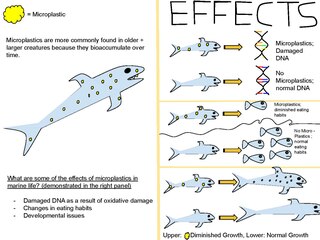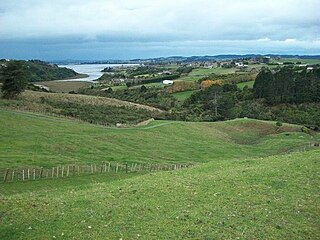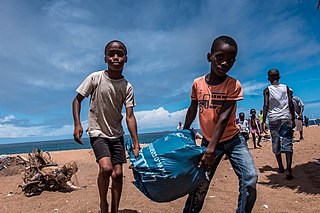
Litter consists of waste products that have been discarded incorrectly, without consent, at an unsuitable location. The word litter can also be used as a verb: to litter means to drop and leave objects, often man-made, such as aluminum cans, paper cups, food wrappers, cardboard boxes or plastic bottles on the ground, and leave them there indefinitely or for other people to dispose of as opposed to disposing of them correctly.

The National Wildlife Federation (NWF) is the United States' largest private, nonprofit conservation education and advocacy organization, with over six million members and supporters, and 51 state and territorial affiliated organizations (including Puerto Rico and the Virgin Islands).

Marine debris, also known as marine litter, is human-created solid material that has deliberately or accidentally been released in a sea or ocean. Floating oceanic debris tends to accumulate at the center of gyres and on coastlines, frequently washing aground, when it is known as beach litter or tidewrack. Deliberate disposal of wastes at sea is called ocean dumping. Naturally occurring debris, such as driftwood and drift seeds, are also present. With the increasing use of plastic, human influence has become an issue as many types of (petrochemical) plastics do not biodegrade quickly, as would natural or organic materials. The largest single type of plastic pollution (~10%) and majority of large plastic in the oceans is discarded and lost nets from the fishing industry. Waterborne plastic poses a serious threat to fish, seabirds, marine reptiles, and marine mammals, as well as to boats and coasts.

The Marine Conservation Society is a UK-based not-for-profit organization working with businesses, governments and communities to clean and protect oceans. Founded in 1978 as the Underwater Conservation Society, the group claims to be working towards "cleaner, better-protected, healthier UK seas where nature flourishes and people thrive." The charity also works in UK Overseas Territories.

Heal the Bay is a U.S. environmental advocacy group of activists based in Santa Monica, California. The focus is protecting coastal waters and watersheds of southern California, and is focused on Santa Monica Bay.

Ocean Conservancy is a nonprofit environmental advocacy group based in Washington, D.C., United States. The organization seeks to promote healthy and diverse ocean ecosystems, prevent marine pollution, climate change and advocates against practices that threaten oceanic and human life.

Marine conservation activism is the efforts of non-governmental organizations and individuals to bring about social and political change in the area of marine conservation. Marine conservation is properly conceived as a set of management strategies for the protection and preservation of ecosystems in oceans and seas. Activists raise public awareness and support for conservation, while pushing governments and corporations to practice sound ocean management, create conservation policy, and enforce existing laws and policy through effective regulation. There are many different kinds of organizations and agencies that work toward these common goals. They all are a part of the growing movement that is ocean conservation. These organizations fight for many causes including stopping pollution, overfishing, whaling and by-catching, and supporting marine protected areas.

Plastic pellet pollution is a type of marine debris originating from the plastic particles that are universally used to manufacture large-scale plastics. In the context of plastic pollution, these pre-production plastic pellets are commonly known as 'nurdles'. These microplastics are created separately from the user plastics they are melted down to form, and pellet loss can occur during both the manufacturing and transport stages. When released into the open environment, they create persistent pollution both in the oceans and on beaches. About 230,000 tonnes of nurdles are thought to be deposited in the oceans each year, where they are often mistaken for food by seabirds, fish and other wildlife. Due to their small size, they are notoriously difficult to clear up from beaches and elsewhere.

Marine plastic pollution is a type of marine pollution by plastics, ranging in size from large original material such as bottles and bags, down to microplastics formed from the fragmentation of plastic material. Marine debris is mainly discarded human rubbish which floats on, or is suspended in the ocean. Eighty percent of marine debris is plastic. Microplastics and nanoplastics result from the breakdown or photodegradation of plastic waste in surface waters, rivers or oceans. Recently, scientists have uncovered nanoplastics in heavy snow, more specifically about 3,000 tons that cover Switzerland yearly.
The Ocean Wise Shoreline Cleanup is a conservation initiative of the Ocean Wise Conservation Association. Shoreline Cleanups offer a unique opportunity for anyone to take action and make a positive impact in their community alongside friends, family, or colleagues. By participating in a cleanup anywhere water meets land, folks can help reduce the amount of litter that ends up in our ocean. Additionally, the litter data collected by volunteers during the cleanup provides Ocean Wise and partners with essential information for addressing pollution at its source.

Society for the Protection of Nature in Israel, or SPNI, is an Israeli non-profit environmental organization working to preserve plants, animals, and natural environments that represent bio-diversity, by protecting the lands and waters needed for their survival, and is Israel's oldest and largest conservation organization.

Kamilo Beach, is a beach located on the southeast coast of the island of Hawaii. It is known for its accumulation of plastic marine debris from the Great Pacific Garbage Patch.

Litter is a global issue and has a significant human impact on the environment. Litter is especially hazardous because it can enter ecosystems and harm a country's biodiversity. Litter is a prevalent environmental issue in New Zealand.
The Hellenic Marine Environment Protection Association or HELMEPA is Europe's first private sector voluntary marine environment protection association. Politicians and notable Greek business men like Andreas Dracopoulos, Sir Stelios Haji-Ioannou, Stavros G. Livanos and Nikolas Tsakos actively support HELMEPA.
Save Our Shores (SOS) is a marine conservation nonprofit dedicated to "foster thriving and sustainable ecosystems in the Monterey Bay and surrounding habitats through equitable environmental action.”
EcoMB, originally named the Environmental Coalition of Miami and the Beaches, is a nonprofit environmental organization headquartered in Miami Beach, Florida. EcoMB was established in 1994 and is a registered 501(c)(3) organization. EcoMB's mission is to educate and promote environmental sustainability and ecological preservation in Florida and Miami-Dade County in particular. The organization lists four primary objectives - reduce litter on beaches, parks, mangroves, waterways and surrounding islands; increase rates of recycling; promote, preserve and restore local coastal habitats; and decrease the greater community's carbon footprint.

Our Seas Our Future (OSOF) is an ENGO group based in Dunedin, New Zealand. OSOF operates as a volunteer driven, non-profit initiative that focuses on coastal and marine conservation advocacy and community engagement projects in New Zealand.
The Plastic Pollution Coalition (PPC) is an advocacy group and social movement organization which seeks to reduce plastic pollution. PPC operates under the fiscal sponsorship of the umbrella organization Earth Island Institute.

Beach cleaning or clean-up is the process of removing solid litter, dense chemicals, and organic debris deposited on a beach or coastline by the tide, local visitors, or tourists. Humans pollute beaches with materials such as plastic bottles and bags, plastic straws, fishing gear, cigarette filters, six-pack rings, surgical masks and many other items that often lead to environmental degradation. Every year hundreds of thousands of volunteers comb beaches and coastlines around the world to clean this debris. These materials are also called “marine debris” or "marine pollution" and their quantity has been increasing due to anthropocentric activities.

A cleanup or clean-up is a form of environmental volunteering where a group of people get together to pick-up and dispose of litter in a designated location. Cleanups can take place on a street, in a neighborhood, at a park, on a water stream, or other public spaces. Cleanup events are often volunteer run. The cleanup volunteers make sure the waste picked-up is disposed of in its appropriate place. Cleanup events are often community-centered and led.















